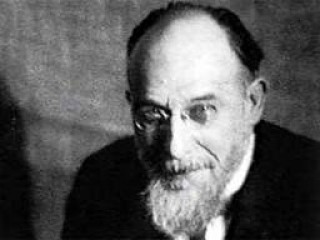
Erik Satie biography
Date of birth : 1866-05-17
Date of death : 1925-07-01
Birthplace : Honfleur, France
Nationality : French
Category : Historian personalities
Last modified : 2011-04-03
Credited as : Composer, and pianist,
Erik Satie was an eccentric but important French composer. His works and his attitude toward music anticipated developments of the next generation of composers.
Erik Satie was born in Honfleur to a French father and a Scottish mother. Because he showed musical talent, he was sent to the conservatory, but his real interest lay in the cafes of Montmartre, where he played the piano and for which he composed sentimental ballads.
From the beginning Satie had a flair for novel musical ideas, and his first serious compositions reveal this originality. The Gymnopedies for piano (1888) avoid all the cliches of the time and strike a note of chasteness, quite different from the feverish and sentimental music of the day. His Three Sarabandes for piano (1887) include some very interesting parallel ninth chords that later became an important feature of the styles of Claude Debussy and Maurice Ravel. In some of his compositions of the next few years Satie used Gregorian modes as well as chords built in fourths, again anticipating musical idioms that would be extensively developed in the next 25 years.
In 1898 Satie "withdrew" to Arcueil, a suburb of Paris, where he spent the rest of his life. He lived quietly, spending a day each week with Debussy, writing cafe music, and studying counterpoint. He gave the piano pieces he wrote at this time ridiculous, almost surrealistically humorous titles, such as Three Pieces in the Shape of a Pear, Three Flabby Preludes for a Dog, and Desicated Embryos—perhaps parodying the elaborately evocative titles Debussy sometimes gave his compositions. Satie also included in his scores such puzzling directions as "play like a nightingale with a toothache," "with astonishment," "from the top of the teeth," and "sheepishly."
Satie's tendency to underplay the importance of his compositions reached its climax in the music he wrote in 1920 for the opening of an art gallery. The score, for piano, three clarinets, and a trombone, consists of fragments of well-known tunes and isolated phrases repeated over and over, like the pattern of wallpaper. In the program he stated, "We beg you to take no notice of the music and behave as if it did not exist. This music … claims to make its contribution to life in the same way as a private conversation, a picture, or the chair on which you may or may not be seated."
This violently antiromantic attitude toward music attracted the attention of the group of young French composers who were to become known as "Les Six" and of Jean Cocteau, their poet-artist-publicity agent. Another group acclaimed Satie as the leader of the "School of Arcueil." Serge Diaghilev commissioned Satie to write the music for a surrealist ballet, Parade (1917). Cocteau wrote the libretto, and Pablo Picasso designed the cubist sets and costumes. Satie's Mercure (1924) and Relache (1924), again with the collaboration of Picasso, anticipated surrealism with their noticeable lack of connection between the action on the stage and the mood of the music. A surrealist movie, part of the ballet, is accompanied by music that alternates between two neutral, "wallpaper" compositions.
Socrate (1919), for four solo sopranos and chamber orchestra, is a serious work. The words are fragments from three Platonic dialogues, one having to do with the death of Socrates. Socrate is distinguished by its atmosphere of calm and gentle repose. It is completely nondramatic, for one of the sopranos sings Socrates's words. The music consists of simple melodic lines and repetitive accompaniment figures. It is this simplicity, this avoidance of the big gesture that made Satie's music important and prophetic of an important branch of 20th-century musical developments.
Two studies of Satie's life and music are Pierre-Daniel Templier, Eric Satie (1932; trans. 1969), which contains many photographs of Satie's friends and family, and Rollo H. Myers, Eric Satie (1948). Roger Shattuck, The Banquet Years (1958), contains an interesting chapter on Satie in the context of Paris in the early years of the century.
















